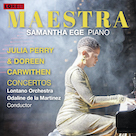

Samantha Ege: Maestra
Lorelt Records
While studying in Italy, American composer Julia Perry was called by locals “Maestra,” a term of endearment pianist Samantha Ege saw fit to adopt as the title for her fifth album, which couples the premiere recording of Perry's Concerto for Piano and Orchestra in Two Uninterrupted Speeds (1969) with Doreen Carwithen's Concerto for Piano and Strings (1948). Also a respected musicologist whose debut book, South Side Impresarios: How Race Women Transformed Chicago's Classical Music Scene, was published in November 2024, Ege is known for her advocacy of Black female composers and has issued recordings of material by Florence Price, Margaret Bonds, Helen Hagan, Undine Smith Moore, and others. Through her recordings and live performances, Ege has repeatedly brought attention to pioneering women, and the light she now shines on Perry (1924-79) and Carwithen (1922-2003) is welcome indeed.
In helping to rescue them from obscurity, Ege is aided in that regard by conductor Odaline de la Martinez, who like the pianist has established herself as a fervent champion of contemporary music. On Maestra, she leads the Lontano Orchestra, which she cofounded in 1976 with flautist Ingrid Culliford, and the release appears on the independent classical imprint she formed in 1992, Lorelt (Lontano Records Ltd), to issue recordings of repertoire overlooked by major labels. Perry was born in Kentucky, but her studies took her far and wide, to Juilliard and the private studios of Nadia Boulanger and Luigi Dallapiccola. Carwithen, on the other hand, was born in Buckinghamshire, England and studied at the Royal Academy of Music. It was at that august institution that she met William Alwyn and soon enough formed a serious relationship with the professor, so much so that by the ‘60s, she'd relinquished composing to dedicate her life to promoting her husband's works (she also later changed her name to Mary Alwyn).
As intimated by its title, Perry's work is an unconventional piano concerto whose two parts are presented, literally, at different speeds; distancing it even more from the norm, it's largely focused on mood-building, texture, and time-suspension, as opposed to Carwithen's, which hews more closely to traditional concerto form. Martinez astutely characterizes the first movement in Perry's concerto “celestial,” and so it is. Materializing softly with strings, woodwinds, and horns, the music gradually comes into focus, with regulated metre suspended and a sense of temporal drift in its place. As the piano tentatively enters, the tone turns pastoral as the musicians paint a quietly rhapsodic scene. In moments vaguely reminiscent of the quieter passages in Copland's Appalachian Spring, the movement embraces a contemplative stance with Ege accenting it with chords and allusive gestures. The second, marked “Fast,” abruptly flips the switch with boisterous energy, swirling woodwinds, and expansive keyboard and percussion flourishes. Pianistic virtuosity is called upon for the performance, which Ege is eminently capable of delivering in the movement's cadenzas.
That Carwithen's piece aligns itself to traditional concerto form is no knock against it, especially when its contrasts of moods are so enriching. Aggressive episodes alternate with sober introspection during the thirty-three-minute presentation, and one's attention is sustained throughout. Before retiring from composing to dedicate herself to her husband's career, she'd established herself as a film composer—quite a feat in the male-dominated movie industry—and true to form vestiges of that cinematic background emerge in the theatrical flair of the concerto. In diametric contrast to the hushed opening of Perry's, Carwithen's enters forcefully with strings paving the way for Ege's equally dramatic entrance. At fourteen minutes, the opening movement is longer than Perry's two combined, and with such room at its disposal the material ranges widely, evoking far-reaching and sometimes folk-tinged vistas as it does. At times, the piano and strings function as sparring partners, at others compatriots uniting in common cause. A late tender episode anticipates the tone of the central movement (“Lento”) but not before some final declamatory flourishes from the instrumentalists. That aforementioned introspection permeates the second movement, with Ege's delicate lyricism sweetly complemented by a violinist's aching solo turn. Vibrancy and energy return for the exuberant drive of the third movement, with the pianist holding fast as the orchestra's wave rises and falls. An extended cadenza grants Ege one last moment in the spotlight, and she capitalizes with a powerful and passionate expression.
Admittedly, an additional piece could have been featured, given that the release is a compact forty-five minutes; Maestra does not, however, feel incomplete. It's a splendid addition to Ege's discography, which she is building patiently step by step with quality recordings. Three years on from Homage, her collaboration with the string quartet Castle of Our Skins, and her solo piano collection Black Renaissance Woman, the pianist continues her advocacy of Black female composers with another exemplary statement.April 2025